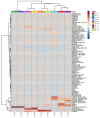An Ascophyllum nodosum-Derived Biostimulant Protects Model and Crop Plants from Oxidative Stress
- PMID: 33396419
- PMCID: PMC7824492
- DOI: 10.3390/metabo11010024
An Ascophyllum nodosum-Derived Biostimulant Protects Model and Crop Plants from Oxidative Stress
Abstract
Abiotic stresses, which at the molecular level leads to oxidative damage, are major determinants of crop yield loss worldwide. Therefore, considerable efforts are directed towards developing strategies for their limitation and mitigation. Here the superoxide-inducing agent paraquat (PQ) was used to induce oxidative stress in the model species Arabidopsis thaliana and the crops tomato and pepper. Pre-treatment with the biostimulant SuperFifty (SF) effectively and universally suppressed PQ-induced leaf lesions, H2O2 build up, cell destruction and photosynthesis inhibition. To further investigate the stress responses and SF-induced protection at the molecular level, we investigated the metabolites by GC-MS metabolomics. PQ induced specific metabolic changes such as accumulation of free amino acids (AA) and stress metabolites. These changes were fully prevented by the SF pre-treatment. Moreover, the metabolic changes of the specific groups were tightly correlating with their phenotypic characteristics. Overall, this study presents physiological and metabolomics data which shows that SF protects against oxidative stress in all three plant species.
Keywords: Ascophyllum nodosum; biostimulant; oxidative stress.
Conflict of interest statement
As S.N. and K.J.G. are employed by BioAtlantis Ltd., they declare a potential conflict of interest. All other authors declare no conflict of interest.
Figures







References
-
- Wani S.H., Kumar V., Shriram V., Sah S.K. Phytohormones and their metabolic engineering for abiotic stress tolerance in crop plants. Crop. J. 2016;7:162–176. doi: 10.1016/j.cj.2016.01.010. - DOI
Grants and funding
- projects PlantaSYST (SGA-CSA No. 739582 under FPA No. 664620) and RESIST (GA 823746)/European Union's Horizon 2020 research and innovation programme
- project BG05M2OP001-1.003-001-C01/European Regional Development Fund through the Bulgarian "Science and Education for Smart Growth" Operational Programme
LinkOut - more resources
Full Text Sources
Miscellaneous

